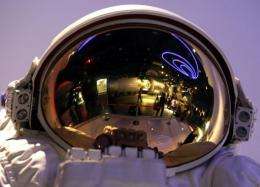Mars explorers will include women, experts say

Men walked on the Moon, but women will be among the pioneering explorers who someday step foot on Mars, said a gathering of top female space experts this week.
Plenty has changed since Neil Armstrong and 11 male successors left their footprints on the Moon from 1969 to 1972, but lingering stereotypes still harm young girls and not enough women reach the upper levels of planetary science, they said.
Some of the leading women at NASA, Lockheed Martin, SpaceX and other organizations came together for a two-day meeting in the nation's capital to discuss their work, how they made it and how the next generation can, too.
"We should tell more girls that this is not a male world," said organizer Artemis Westenberg, president of the education and lobbying group Explore Mars.
Of the 350 women in the United States with doctorates in planetary science, only 39 are employed at NASA, according to Susan Niebur, a US space agency mission consultant and founder of Women in Planetary Science.
"I wonder, where are the other women and what amazing science explorations might they have proposed?" she said. "We are still losing a lot of women in the pipeline."
Some women have made it onto the management teams of recent Mars projects, but in small numbers, according to an analysis presented by Linda Billings, a research professor at George Washington University.

For instance, the management of the 1997 Mars Pathfinder project had seven men and one woman; the 2004 Mars Exploration Rover project had two women and eight men; and two women are among 13 male "key team members" of the Mars Science Laboratory set to launch later this month.
Those who have made it have faced obstacles, ranging from trying to maneuver in spacesuits designed for men who are six feet (1.8 meter) tall to facing blunt cultural biases about the role of women.
Astronaut Cady Coleman, a veteran of two shuttle missions who has lived aboard the International Space Station with male colleagues for six months, shared her frustration at constantly being asked, by media and others, if she missed her family back on Earth.
"People would say 'How does it feel to be away from your son during all this time?' And part of me wants to say, 'Do you ask the guys these questions?' Because they actually don't, and it is wrong for two reasons:
"One, the guys miss their kids and their spouses just as much; and two, we are doing this because we think the work that we do is important."
When a male guest in the audience rose to ask her how female astronauts managed their menstrual periods in space, Coleman did not flinch, explaining that she had had surgery and was past those days.
"But it is actually a valid question for just different cultural things," she said.
"The Russians are convinced that women on their cycle are going to ruin the toilet," she said. "We have the exact same toilet on the US side (of the space station). Turns out, we can use it," she said with a laugh.
Following their passions, learning to ignore biases and keeping focused on studying are key parts of their journey to top posts at NASA and beyond, the speakers said.
"We have to encourage our girls to work really hard. This is hard stuff and you have got to be prepared," said Sandy Coleman, director NASA exploration programs.
Women who are already working on the next Mars missions shared their research, from designing the spacecraft to devising science experiments to studying how to protect astronauts' health from bone loss and radiation during long-distance missions.
"It is not a question of who is better, faster, smarter," said Saralyn Mark, NASA chief health and medical officer. "What we have learned over the years is how to do specific countermeasures to protect the health of both men and women."
Mark also lamented the absence of women in a 520-day Mars simulation experiment that ended earlier this month and included six men -- one Chinese, one Italian, one Frenchman and three Russians -- camped in a Moscow parking lot.
"To some of our Russian colleagues, I think it was a fascinating experiment but it would have been more valuable to have both men and women. That is something that needs to be seriously considered."
Since Mars is 150 times further away from the Earth than the Moon, any trip there and back is likely to take a full year and a half.
The first human exploration mission, perhaps to one of Mars' two moons, may happen by 2033, said Linda Karanian, Lockheed Martin director of human space flight operations, though the crew is far from being selected yet.
"Eleven- and twelve-year-olds are probably where you want to start capturing the interest and the enthusiasm," said Karanian. "There is going to be a select few."
Despite challenges that may remain, the days when women were excluded from space exploration are over, said Colleen Hartman, NASA assistant associate administrator, science mission directorate.
"Men went to the Moon but everyone will be going to Mars."
(c) 2011 AFP


















